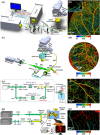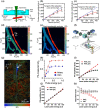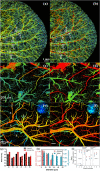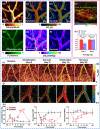Functional photoacoustic microscopy of hemodynamics: a review
- PMID: 35529339
- PMCID: PMC9046529
- DOI: 10.1007/s13534-022-00220-4
Functional photoacoustic microscopy of hemodynamics: a review
Abstract
Functional blood imaging can reflect tissue metabolism and organ viability, which is important for life science and biomedical studies. However, conventional imaging modalities either cannot provide sufficient contrast or cannot support simultaneous multi-functional imaging for hemodynamics. Photoacoustic imaging, as a hybrid imaging modality, can provide sufficient optical contrast and high spatial resolution, making it a powerful tool for in vivo vascular imaging. By using the optical-acoustic confocal alignment, photoacoustic imaging can even provide subcellular insight, referred as optical-resolution photoacoustic microscopy (OR-PAM). Based on a multi-wavelength laser source and developed the calculation methods, OR-PAM can provide multi-functional hemodynamic microscopic imaging of the total hemoglobin concentration (CHb), oxygen saturation (sO2), blood flow (BF), partial oxygen pressure (pO2), oxygen extraction fraction, and metabolic rate of oxygen (MRO2). This concise review aims to systematically introduce the principles and methods to acquire various functional parameters for hemodynamics by photoacoustic microscopy in recent studies, with characteristics and advantages comparison, typical biomedical applications introduction, and future outlook discussion.
Keywords: Calculation methods; Hemodynamics; Multi-functional imaging; Photoacoustic imaging.
© Korean Society of Medical and Biological Engineering 2022.
Conflict of interest statement
Conflict of interestThe authors have no conflicts of interest to declare.
Figures








Similar articles
-
Photoacoustic computed microscopy.Sci Rep. 2014 May 14;4:4960. doi: 10.1038/srep04960. Sci Rep. 2014. PMID: 24828539 Free PMC article.
-
Simultaneous photoacoustic microscopy of microvascular anatomy, oxygen saturation, and blood flow.Opt Lett. 2015 Mar 15;40(6):910-3. doi: 10.1364/OL.40.000910. Opt Lett. 2015. PMID: 25768144
-
Seeing through the Skin: Photoacoustic Tomography of Skin Vasculature and Beyond.JID Innov. 2021 Jun 25;1(3):100039. doi: 10.1016/j.xjidi.2021.100039. eCollection 2021 Sep. JID Innov. 2021. PMID: 34909735 Free PMC article. Review.
-
Photoacoustic Microscopy.Laser Photon Rev. 2013 Sep 1;7(5):10.1002/lpor.201200060. doi: 10.1002/lpor.201200060. Laser Photon Rev. 2013. PMID: 24416085 Free PMC article.
-
Resolution Enhancement Strategies in Photoacoustic Microscopy: A Comprehensive Review.Micromachines (Basel). 2024 Nov 30;15(12):1463. doi: 10.3390/mi15121463. Micromachines (Basel). 2024. PMID: 39770216 Free PMC article. Review.
Cited by
-
Fully integrated photoacoustic microscopy and photoplethysmography of human in vivo.Photoacoustics. 2022 May 20;27:100374. doi: 10.1016/j.pacs.2022.100374. eCollection 2022 Sep. Photoacoustics. 2022. PMID: 35646590 Free PMC article.
-
Review of Three-Dimensional Handheld Photoacoustic and Ultrasound Imaging Systems and Their Applications.Sensors (Basel). 2023 Sep 28;23(19):8149. doi: 10.3390/s23198149. Sensors (Basel). 2023. PMID: 37836978 Free PMC article. Review.
-
In vivo photoacoustic tomography of porcine abdominal organs using Fabry-Pérot sensing integrated platform.Eur Radiol Exp. 2025 Jul 9;9(1):65. doi: 10.1186/s41747-025-00601-1. Eur Radiol Exp. 2025. PMID: 40634645 Free PMC article.
-
Motion Compensation for 3D Multispectral Handheld Photoacoustic Imaging.Biosensors (Basel). 2022 Nov 29;12(12):1092. doi: 10.3390/bios12121092. Biosensors (Basel). 2022. PMID: 36551059 Free PMC article.
-
Evidence of cortical vascular impairments in early stage of Alzheimer's transgenic mice: Optical imaging.J Cereb Blood Flow Metab. 2025 May;45(5):960-976. doi: 10.1177/0271678X241304893. Epub 2024 Dec 18. J Cereb Blood Flow Metab. 2025. PMID: 39696904
References
Publication types
LinkOut - more resources
Full Text Sources
Other Literature Sources
Miscellaneous
